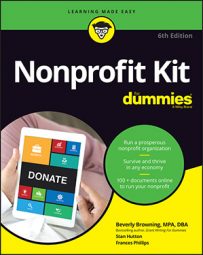The number of options available can be daunting. When choosing one, think about the giving experience both from the point of view of your nonprofit and from the perspective of your donor.
From the perspective of your nonprofit, look carefully at how and for what an agency charges fees. Most online contribution services charge a setup fee, a monthly fee, and a per-contribution fee. Sometimes you can avoid the monthly fee, but when you do, you often pay a higher fee for each contribution you receive. Some less-expensive nonprofit technology services charge lower fees but send you your contributions in a lump sum, so you only receive the money, not the donor records.On the other hand, some services charge for keeping the donor records or for allowing you to upload them onto your computers. You also will want to check on ease of use, and number of types of credit cards accepted. Some services will allow you to add boxes on the donor form where your contributors can select premium gifts or choose to receive a newsletter.
You also want to consider the experience of making the donation from the point of view of your donors. With some services, such as PayPal and Network for Good’s basic DonateNow, when a donor clicks on the Donate Now button on your website, she can immediately tell that she’s making her gift through a different website.
Check to see if the service you’re using will allow you to modify the look of that donation form so that it matches the look and feel of your website and graphics. This can reassure nervous donors that they’re in the right place.
Check Idealware’s website for helpful, updated articles about choosing online donation and credit-card processing tools.
If you hire a marketing service to develop and maintain your organization’s website, consider the breadth of the services you’re purchasing. Will the agency design your website for you? Will it thank your donors? Will it integrate data about customers who pay to attend your workshops with information about those who contribute money? Will it manage a donor database for your online contributions? And is it a 501(c)(3) nonprofit organization or a for-profit entity? (If it is a nonprofit, it may be registered to raise funds in all states requiring such registrations and this could save your organization significant fees.)
Finding financial support from a crowd
Another method of raising money online, crowdfunding or crowdsourcing, involves seeking donations from people whom you reach through your email records or social media. Potential donors may learn only about your project or they may be directed to a page that features a dozen or more projects to choose among — one of which is yours.Crowdfunding services provide individuals and enterprises with tools to conduct focused, time-sensitive campaigns to raise money. Someone seeking contributions must name a specific amount to be raised and a specific project to be launched or completed. Some crowdfunding services (such as Kickstarter) are “all or nothing,” meaning fundraisers don’t receive any of the pledged gifts until they meet their goals.
Although this can seem to be a drawback, it also can motivate donors to give larger gifts or make additional contributions after their initial investments. Crowdfunding isn’t exclusively for nonprofit organizations, but some platforms that include nonprofits among their clients are Fundly, Indiegogo, Kickstarter (for creative projects), and Kiva (for interest-free micro-loans).
Distributing your fundraising through volunteers
Technology provides novel ways for your organization’s supporters to help raise money. In distributed fundraising, sometimes called “peer-to-peer fundraising,” an individual supporter creates an online donation account for your organization, and through that account speaks directly to friends and family about your organization’s work, urging them to contribute or volunteer. Often they do this in concert with a campaign you’re promoting directly. This is a great thing to ask your board members or tech-savvy volunteers to do for you.A peer-to-peer fundraiser can add a widget or badge that can be added to a website, blog, or social media page. They then distribute the page through their networks (for example, to subscribers to their blogs). Your volunteer fundraiser often uses an existing service to set up the page and collect contributions. Some of these services are Network for Good, Change.org, Changing the Present, FirstGiving, and Causes.com. Your volunteer will want to pay attention to the comparable setup fees and percentages of contributions collected by these services.
While involving your known supporters and volunteers to help raise money for your nonprofit is a great idea, there is a risk in distributed fundraising if an individual who is not authorized or known by the nonprofit raises funds in the name of the organization. If this situation arises, you should contact the donor and the fundraising platform to stop the unauthorized solicitations.

